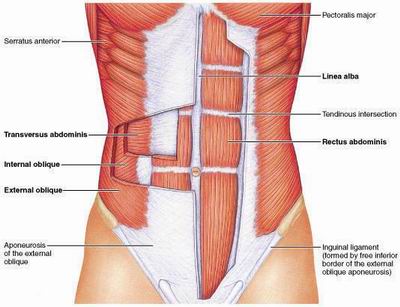Core 101
Written by Stacy Benmore – Physiotherapist
“You need to work on your core muscles.” How many times have you heard this or read about it in a magazine? Core stability strength is reported to help decrease low back pain, prevent injuries, and help athletic performance. We know how important it is, but how do you know if you’re truly strengthening your core? Often in clinical practice I encounter clients who think they are recruiting the proper muscles only to learn that in fact the core muscles are not being isolated at all. This does not mean that all their exercise efforts have gone to waste; rather that they are not getting maximal “bang for their buck”. Here is a short anatomy lesson and some handy cues to get you truly “working your core”:
Essentially, you have two sets of abdominal muscles that each have a separate job to do. Closest to the surface of the skin is the outer unit, consisting of rectus abdominus (the “six-pack”), and the obliques (inner and outer). The job of the outer unit is to move your trunk – forward bending with or without some rotation. The inner unit underlies this, and consists of the transversus abdominus muscle, pelvic floor muscles, and lumbar spine multifidus. The job of the inner unit is to stabilise or maintain the position of the trunk before you move arms/legs.
With two sets of muscles that have opposite jobs, it becomes important to know how to recruit the inner unit properly.
Transversus abdominus: Lying on your back at the end of an exhaled breath, gently draw your belly button inward and upward. Do not expand your rib cage, or push your lower back into the floor.
Multifidus: Lying on your side, place your hands on your back and find your spine. Slide your hands just outward so they fall off the bony spine into a little valley (your fingers should be approximately 2-3cm away from each other). Without clenching your back muscles, draw transversus abdominus in from the front, and imagine connecting it to where your fingers are – the skin under your fingers should gently swell. This will be more challenging than transversus and will take more practice upward. Do not expand your rib cage, or push your lower back into the floor.
Pelvic floor: Lying on your back with knees bent, recruit the muscles that you would use to stop urinating – slowly lift them upward toward your abdomen. Keep breathing, and work to connect these muscles to your transversus abdominus.
This is a brief overview. All of this will take some practice. Ask your physiotherapist, yoga/pilates instructor, or fitness trainer to check and help ensure you are getting the most out of these muscles. They may have more suggestions and cues that will be helpful to you.



